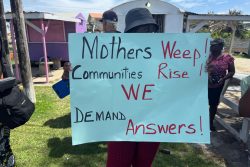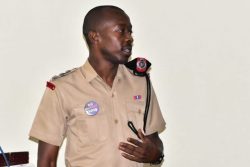 2024 is upon us! And with a new year’s imminent arrival, it is customary to reflect on the concluding year and formulate plans for the year ahead. Of course, sometimes the reflections inspire feelings of satisfaction and internal articulations for a job well done but they can also inspire sadness, regret, and other feelings of discontent for what could have been done differently. But alas, living in the past prevents us from taking advantage of the many opportunities in the present.
2024 is upon us! And with a new year’s imminent arrival, it is customary to reflect on the concluding year and formulate plans for the year ahead. Of course, sometimes the reflections inspire feelings of satisfaction and internal articulations for a job well done but they can also inspire sadness, regret, and other feelings of discontent for what could have been done differently. But alas, living in the past prevents us from taking advantage of the many opportunities in the present.
2024 offers new possibilities and scope for improvement on what worked in 2023. For the student or professional artist, it may be worth doing a thorough assessment of the concluding year. What plans did you enter January 2023 with? Were these plans realised? How were they realised and are there favourable aspects to the process or outcomes that are worth building on? I don’t encourage lamenting on what failed, but a rational acknowledgment and reflection to chart a modified course forward is advocated. Could it be that more or more effective collaboration was necessary to realise the grand plan? Or perhaps different collaborators were needed altogether? Could it be that the sum total of plans was too ambitious for the time that was allotted and the resources available? So, perhaps the plans can be revisited but more time allocated to them to allow for errors and corrections, missteps and redirection so the plans may manifest better, if not very well.
Maybe the 2024 plan is to build one’s art network. Today with social media and the ease of communication this is so much more easily done than even a decade ago. And Covid, for all the havoc it brought, made connecting with artists in the wider geographic and diasporic Caribbean so much more possible. With Covid, one formidable bi-monthly in-person gathering of Caribbean and Caribbean-descended artists in the UK became a virtual one with its doors opened to artists across the Atlantic in North America and the Caribbean including the mainland territories of Belize, Guyana, and Suriname. Thus, worthy transnational and inter-generational dialogue was fostered. Meanwhile, formal institutions in the US that serve Caribbean people have allowed some of their programming to remain online so that Caribbean-based artists and creatives can partake in them. Thus, the insularity one might have felt in Guyana’s small art space just three years ago is no more because of the scope to build networks beyond the limits of our space. But widening one’s network is not only beneficial to having art-savvy folks with whom to discuss art – particularly one’s art – but out of such networks can come one of the holy grails for a Guyana-based artist – opportunities to show work outside of Guyana where the potential for the work’s critical appraisal is greater. Critical engagement can be very generative for the development of one’s art practice.
Maybe the 2024 plan is to make and show new art lest the small viewing public gets fatigued with seeing the same things over and over. Perhaps in doing so, artists will subject their work to robust critical assessment of their employ of the formal elements – the elements of art and the principles of design – as well as evaluation of the functionality of the work. By the latter I mean, is the work intending to function as more than an exercise of the hands translating what the eye sees or the mind imagines? Is the work intending to help the viewer to self-reflect or is it a critique of social-cultural norms that need revising or full dismantling? Is the work intending to call forth a more egalitarian social space? Less racism. Less sexism. Less classism. Less capitalist exploitation. Maybe in 2024, the plan is for art that serves the betterment of our society.
I wonder whether in 2024 art exhibitions will be more deliberately and carefully executed so that audiences are not subjected to any and everything re-presented in paint, mediated through the lens of a camera, or carved in wood. I wonder whether more care will be taken in deciding what is shown in exhibitions and how the work is shown. I wonder too whether the decisions about what is and is not shown will be based on clearly defined consistent criteria rather than biases and fluidity of criteria. And as I think of biases, I wonder whether in 2024 our singular exhibition-purposed space will once again return to its short-lived reality of being a place where artists of Guyana could show work irrespective of their party allegiances and other friendships. It is a sad truth when access to show work in this singular exhibition-purposed space is mediated by a high official rather than the persons who should form a governing board. Perhaps in 2024, the Management Committee of this singular exhibition-purposed space will be reconstituted and those who constitute it will ground their decisions in fairness rather than fear and nepotism.
Perhaps the most memorable art exhibition in 2023 was that which was hosted by the Technical Vocational Education Training (TVET) Unit of the Ministry of Education early in November. The exhibition which filled both the ground floor and middle flat of the National Gallery of Art (therefore, all of the currently available exhibition space) comprised dozens of works from high schoolers alongside works by high school art teachers. Along with the works hung within the Gallery, on its lawns, artists and art institutions showed their work and advertised their art training programmes respectively. Meanwhile, the pan bands of Queen’s College, St Rose’s High, and President’s College entertained exhibitors and visitors alike. It was encouraging to see the school children’s range of thematic and technical expression. Considering that visual art gets maligned in schools it was heartening to see the strength of work from the students. I look forward to another such art event in 2024 and hope that fragments of the large Georgetown exhibition can tour Guyana.
It is hoped that in 2024, the organisers of last February’s Rufaro Center and Roots and Culture Gallery exhibition will once again host an art exhibition but with at least contextualising text. It is also hoped that the E R Burrowes School of Art (BSA) will host a more careful selection of graduating student work and that the University of Guyana’s Division of Creative Arts (DCA) will host its annual exhibition with more work from its continuing students. It is hoped that the Moving Circle will host their annual Heritage Month exhibition with more carefully considered installation pieces and accompanying text (should they attempt to do so again) and that the FineArt.gy team will be able to host another pop-up exhibition but with more new and unfamiliar work. While the BSA must be commended for hosting a separate exhibition of work by staff (unlike the DCA), it is hoped that they too will allow the exhibition to be of mostly new work.
And finally, I hope the Guyana Women Artists’ Association after a dismal 2022 show which perhaps accounted for the 2023 exhibition hiatus, will return with strength.
It has been said, “if you expect the worst, you’ll never be disappointed.” We as a community of artists in Guyana cannot afford such pessimism. Therefore, as we say farewell to 2023 and 2024 approaches, we need to be optimistic. I know I must be optimistic because pessimism lulls the mind into a state of apathy and the soul withers for lack of nourishment. So, while I reference some adverse truths of art practice in Guyana, I am hopeful that 2024 will be a year of growth and maturity for our community evidenced by well-functioning networks and formal associations, strong and harmonious collaborations, better art, and better exhibition-making.









